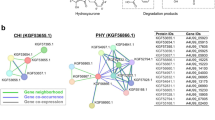Abstract
The human fecal anaerobe Eubacterium ramulus is capable of degrading various flavonoids, including the flavone naringenin. The first step in the proposed degradation pathway is the isomerization of naringenin to the corresponding chalcone. Cell-free extracts of E. ramulus displayed chalcone isomerase activity. The enzyme from E. ramulus was purified to homogeneity. Its apparent molecular mass was estimated to be 136 and 129 kDa according to gel filtration and native polyacrylamide gel electrophoresis, respectively. Chalcone isomerase is composed of one type of subunit of 30 kDa. The purified enzyme catalyzed the isomerization of naringenin chalcone, isoliquiritigenin, and butein, three chalcones that differ in their hydroxylation pattern. N-bromosuccinimide, but also naringenin and phloretin, inhibited the purified enzyme considerably. This is the first report on a bacterial chalcone isomerase. The physiological function of the purified enzyme is unclear, but an involvement in the conversion of the flavanone naringenin to the chalcone is proposed.




Similar content being viewed by others
References
Bednar RA, Hadcock JR (1988) Purification and characterization of chalcone isomerase from soybeans. J Biol Chem 263:9582–9588
Bednar RA, Fried WB, Lock YW, Pramanik B (1989) Chemical modification of chalcone isomerase by mercurials and tetrathionate. J Biol Chem 264:14272–14276
Boland MJ, Wong E (1975) Purification and kinetic properties of chalcone-flavanone isomerase from soya bean. Eur J Biochem 50:383–389
Dixon RA, Dey PM, Whitehead IM (1982) Purification and properties of chalcone isomerase from cell suspension cultures of Phaseolus vulgaris. Biochim Biophys Acta 715:25–33
Dixon RA, Blyden ER, Robbins MP, Van Tunen AJ, Mol JN (1988) Comparative biochemistry of chalcone isomerases. Phytochemistry 27:2801–2808
Erlund I, Meririnne E, Alfhan G, Aro A (2001) Plasma kinetics and urinary excretion of the flavanones naringenin and hesperetin in humans after ingestion of orange juice and grapefruit juice. J Nutr 131:235–241
Fouché SD, Dubery IA (1994) Chalcone isomerase from Citrus sinensis: purification and characterization. Phytochemistry 37:127–132
Gensheimer M, Mushegian A (2004) Chalcone isomerase family and fold: no longer unique to plants. Protein Sci 13:540–544
Jez JM, Noel JP (2002) Reaction mechanism of chalcone isomerase. J Biol Chem 277:1361–1369
Jez JM, Bowman ME, Dixon RA, Noel JP (2000) Structure and mechanism of the evolutionarily unique plant enzyme chalcone isomerase. Nat Struct Biol 7:786–791
Laemmli UK (1970) Cleavage of structural proteins during the assembly of the head of bacteriophage T4. Nature 227:680–685
Lineweaver H, Burk D (1934) The determination of enzyme dissociation constants. J Am Chem Soc 56:658–666
Moustafa E, Wong E (1967) Purification and properties of chalcone-flavanone isomerase from soy bean seed. Phytochemistry 6:625–632
Pillai BVS, Swarup S (2002) Elucidation of the flavonoid catabolism pathway in Pseudomonas putida PML2 by comparative metabolic profiling. Appl Environ Microbiol 68:143–151
Robbins MP, Dixon RA (1984) Induction of chalcone isomerase in elicitor-treated bean cells. Comparison of rates of synthesis and appearance of immunodetectable enzyme. Eur J Biochem 145:195–202
Ross JA, Kasum CM (2002) Dietary flavonoids: bioavailability, metabolic effects, and safety. Annu Rev Nutr 22:19–34
Schneider H, Blaut M (2000) Anaerobic degradation of flavonoids by Eubacterium ramulus. Arch Microbiol 173:71–75
Schneider H, Schwiertz A, Collins MD, Blaut M (1999) Anaerobic transformation of quercetin-3-glucoside by bacteria from the human intestinal tract. Arch Microbiol 171:81–91
Shin YW, Bok SH, Jeong TS, Bae KH, Jeoung NH, Choi MS, Lee SH, Park YB (1999) Hypocholesterolemic effects of naringin associated with hepatic cholesterol regulating enzyme changes in rats. Int J Vitam Nutr Res 69:341–347
Simmering R, Kleessen B, Blaut M (1999) Quantification of the flavonoid-degrading bacterium Eubacterium ramulus in human fecal samples with a species-specific oligonucleotide hybridization probe. Appl Environ Microbiol 65:3705–3709
Terai Y, Fujii I, Byun S-H, Nakajima O, Hakamatsuka T, Ebizuka Y, Sankawa U (1996) Cloning of chalcone-flavanone isomerase cDNA from Pueraria lobata and its overexpression in Escherichia coli. Protein Expr Purif 8:183–190
Tomás-Barberán FA, Clifford MN (2000) Flavanones, chalcones and dihydrochalcones-nature, occurrence and dietary burden. J Sci Food Agric 80:1073–1080
Van Acker FAA, Schouten O, Haenen GRMM, Van der Vijgh WJF, Bast A (2000) Flavonoids can replace α-tocopherol as an antioxidant. FEBS Lett 473:145–148
Yang M, Tanaka T, Hirose Y, Deguchi T, Mori H, Kawada Y (1997) Chemopreventive effects of diosmin and hesperitin on N-butyl-N-(4-hydroxybutyl)nitrosamine-induced urinary-bladder carcinogenesis in male ICR mice. Int J Cancer 73:719–724
Acknowledgment
This work was supported by the Deutsche Forschungsgemeinschaft (grant no. INK 26/B1-1).
Author information
Authors and Affiliations
Corresponding author
Rights and permissions
About this article
Cite this article
Herles, C., Braune, A. & Blaut, M. First bacterial chalcone isomerase isolated from Eubacterium ramulus . Arch Microbiol 181, 428–434 (2004). https://doi.org/10.1007/s00203-004-0676-2
Received:
Revised:
Accepted:
Published:
Issue Date:
DOI: https://doi.org/10.1007/s00203-004-0676-2




